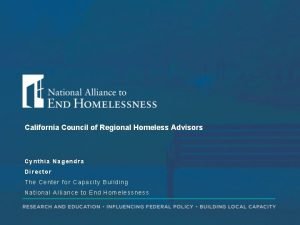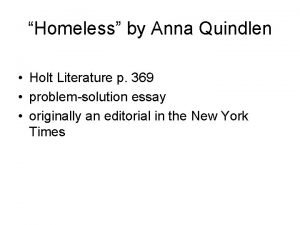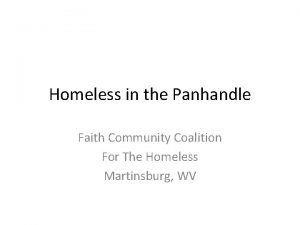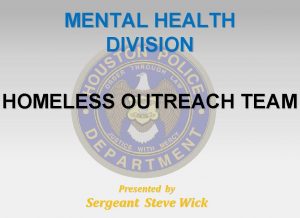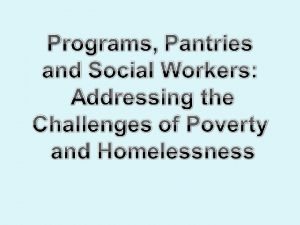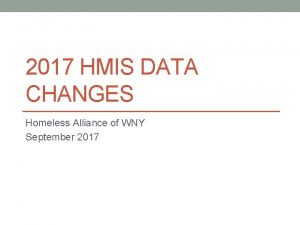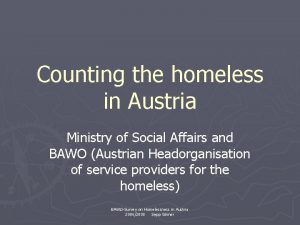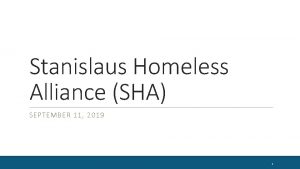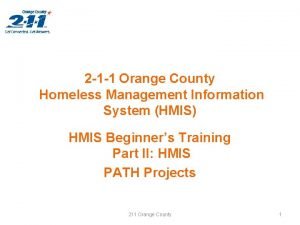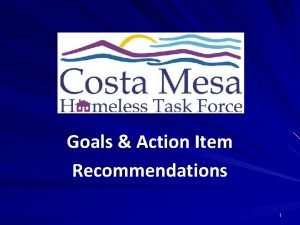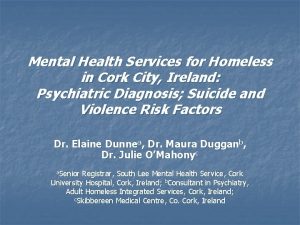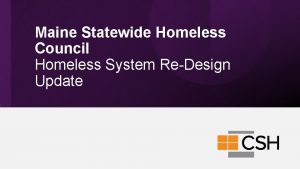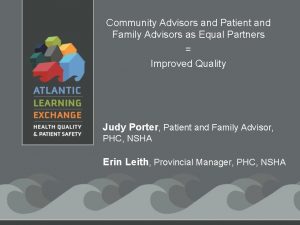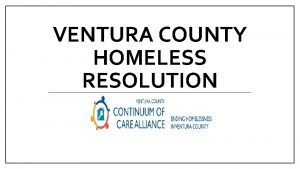California Council of Regional Homeless Advisors Cynthia Nagendra






























- Slides: 30

California Council of Regional Homeless Advisors Cynthia Nagendra Director The Center for Capacity Building National Alliance to End Homelessness

The National Alliance to End Homelessness is The National Alliance to End Homelessness the leading national voice on the issue of identifies and evaluates hundreds of policy homelessness. The Alliance analyzes policy and project strategies and their impact on and develops pragmatic, effective policy homelessness. The Alliance’s Center for solutions. The Alliance works collaboratively Capacity Building helps communities with the public, private, and nonprofit sectors to replicate and customize the best of those build state and local capacity, leading to strategies. The Center focuses on strategies stronger projects and policies that help that are cost effective, data driven, and can communities achieve their goal of ending be implemented at a scale that can homelessness. significantly reduce homelessness.

Agenda • What are the key elements and goals of an effective homeless response system of care that prevents and ends homelessness? • What role do emergency shelters/temporary/interim housing play in a homeless response system of care? • What are key elements of effective shelter models? • What considerations should be made when adding new shelter beds or designing with temporary responses to unsheltered homelessness?

About Homelessness • Homelessness is housing-driven economic problem • Homelessness happens because incomes don’t match housing costs] • Shortage of rental homes affordable and available for extremely low-income renters in CA: -1, 019, 190 • Percent of extremely low-income renter households with severe cost burden: 76% • A toxic combination of slow wage growth + skyrocketing rents puts housing out of reach for many in CA • Zillow’s research found that a 5% increase in rents in L. A. translates into about 2, 000 more homeless people, among the highest correlations in the U. S.

About Homelessness • The lack of affordable housing has a dual effect: 1. pushes more people into the homelessness system 2. makes it more difficult to help people exit into housing • Because there is not enough affordable housing, many poor households are unstable in housing and are at risk of or become homeless

WHAT IS AN EFFECTIVE HOMELESS RESPONSE SYSTEM?

Effective Homeless Response System: Goal House people as quickly as possible and divert people from imminent homelessness whenever possible

Effective Homeless Response System: Approach Use a systemic approach to align interventions and resources across programs in a coordinated way around this common goal

Effective Homeless Response System: Elements • Skilled outreach connected to shelter, housing, systems of care, law enforcement • Low-barrier and housing-focused emergency shelter • Permanent housing • Self-resolution, diversion, prevention services • Rapid re-housing (short/medium-term rental subsidy and services) • Permanent supportive housing (long-term rental subsidy with intensive services) • Natural and community supports, coordination with mainstream systems of care, and housing stabilization services

Effective Homeless Response System: Increase System Flow is an efficient and coordinated process that moves people from homelessness to housing as quickly as possible.

Poor System Flow • Unchanging or increasing number of unsheltered people • Waitlists for shelter • Long lengths of stay in shelter (more than 30 days) • High percentage of exits from shelters to homelessness • Average length of homelessness is not decreasing • In-flow into homelessness is steady or increasing • Long waitlists for RRH and PSH • Significant amount of people aren’t getting any kind of assistance

An Effective Homeless Response Means… • Right-sizing your system • Balancing temporary responses with permanent housing solutions • Having permanent re-housing capacity to scale • Treating each person’s episode of homelessness as an URGENT CRISIS that needs a quick permanent housing resolution

THE CRITICAL ROLE OF EMERGENCY SHELTERS IN AN EFFECTIVE HOMELESS RESPONSE SYSTEM

Terms • • • Emergency Shelter Crisis Beds Interim Housing Bridge Housing Navigation Centers Temporary place to stay during a housing crisis

Why Are Shelters So Important? Shelter is often a community’s immediate response to a housing crisis

Shelters Play a Critical Role in an Effective Homeless Response System • People in a housing crisis need a safe and decent place to go that is immediately available and accommodates their needs • Shelters can help people return to housing • Shelters can decrease system flow if people can’t get in or get stuck there for long periods of time

Shelters Must Have a Housing Exit Strategy • Emergency shelters play a critical, often life-saving role in providing a safe place for people experiencing a housing crisis • But, providing a shelter bed alone is often a temporary, inadequate fix to homelessness • Shelters must be designed as part of a process to getting housed

Goal of Shelter: Traditional Model • To provide temporary shelter and safety • Dormitory/Hostel-like environment (check-in and check out every day) • Open only at night • Meets basic needs • Shower/bathroom • Laundry • Mail • Self-directed resource/information and referral • Inadequate case management/no housing search services

Goal of Shelter in an Effective System: Provide a Low-Barrier Path to Housing • To provide temporary shelter and safety • Hostel-like environment (check-in and check out every day) • Large, congregate-style • Meets basic needs • Shower/bathroom • Laundry • Mail • Self-directed resource/information and referral • Light services • To provide a path to housing • Resolve housing crises permanently • Open 24/7 • Facilitate self-resolution • Re-house people quickly • Reduce unsheltered homelessness • Connect people to housing search and other resources to help stabilize them once housed

Current “High-barrier” Shelters May Not Accommodate Unsheltered People’s Needs • We ask people to go to shelters that are inadequate for their needs and are not offering a permanent solution that will end their homelessness • We ask people to fit our existing programs, rather than changing our programs to fit people’s actual needs • Many people refuse to stay in shelters because they are not accommodating of their needs or have too many rules • • No Partners No Pets Sobriety Limited Hours of operation Too many rules Unsafe Unclean Crowded


New Low-barrier, Housing-focused Shelter Model • Shelter is NOT a destination • Shelter is part of a process of getting people housed • The shelter is equipped and resourced to help people get housed as soon as they come into shelter • Everything in the shelter is laser-focused on getting people housed with whatever resources they have or connecting them to available housing programs

People have to be able to get in…

People have to be able to get in…. . . and be able to get out (to housing).


Measure Outcomes DECREASE Long-stays INCREASE Exits to permanent housing DECREASE Returns to shelter INCREASE Shelter utilization

CONSIDERATIONS FOR ADDING SHELTER CAPACITY OR DESIGNING EMERGENCY RESPONSES TO UNSHELTERED HOMELESSNESS

Assessing Your Community’s Need for Crisis Resources • Are we optimizing our current shelter capacity by making it low-barrier and housing-focused to improve system flow? • Are we accommodating the needs of people who are living unsheltered? • Are we designing responses for people who are not getting adequately served? • Are we designing each new shelter bed with a housing exit resource?

Key Considerations for Emergency Responses Planning for “right now” solutions must include attention to: • Safety • Human dignity Optimal “right now” solution Dignity • Housing xit strategies Safety Housing Exit Strategies

Contact Cynthia Nagendra Director Cnagendra@naeh. org
 Cynthia nagendra
Cynthia nagendra Southampton city council homeless
Southampton city council homeless Nagendra modadugu
Nagendra modadugu California urban water conservation council
California urban water conservation council Ken zagzebski
Ken zagzebski California council on gerontology and geriatrics
California council on gerontology and geriatrics Flint hills regional council
Flint hills regional council Central highlands regional council tenders
Central highlands regional council tenders Home stretch alameda county
Home stretch alameda county Homeless anna quindlen
Homeless anna quindlen Homeless coalition martinsburg wv
Homeless coalition martinsburg wv Hpd mental health division
Hpd mental health division Will smith movie homeless
Will smith movie homeless Hmis wny
Hmis wny Homelessness in austria
Homelessness in austria Stanislaus homeless alliance
Stanislaus homeless alliance Homelessness outcome star
Homelessness outcome star Elizabeth murray harvard
Elizabeth murray harvard Chronically homeless orange county
Chronically homeless orange county The hunchback in the park
The hunchback in the park Dress homeless
Dress homeless Costa mesa homeless
Costa mesa homeless Homeless artinya
Homeless artinya Thomas benjamin kennington
Thomas benjamin kennington Homeless services cork
Homeless services cork Homeless shelters southend
Homeless shelters southend Michael oher homeless
Michael oher homeless Senior market advisors
Senior market advisors Fidelity advisors 529
Fidelity advisors 529 Job market for certified crop advisors
Job market for certified crop advisors Acu academic advisors
Acu academic advisors
